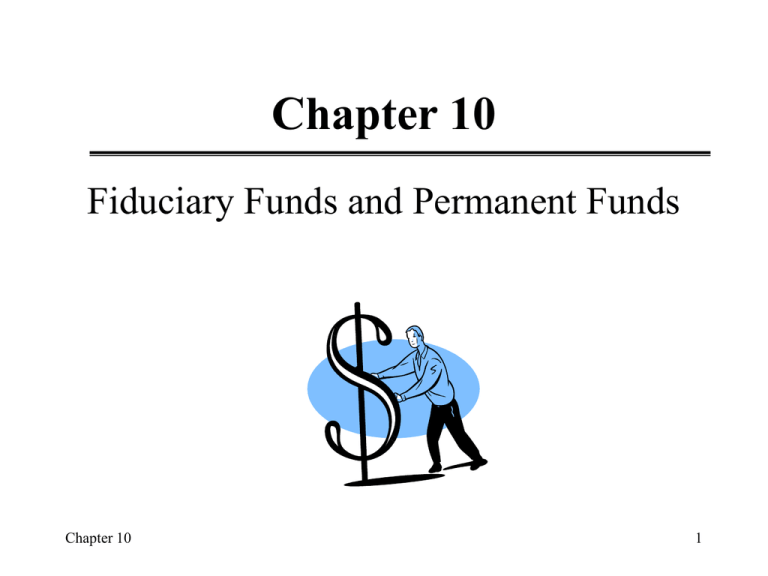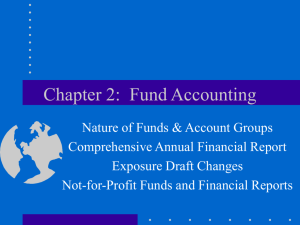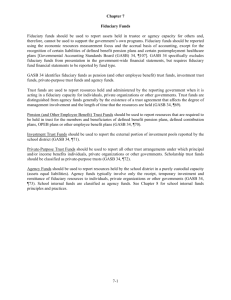
Chapter 10
Fiduciary Funds and Permanent Funds
Chapter 10
1
Learning Objectives
Endowment
Permanent and Fiduciary Funds
Expendable and Nonexpendable Trust Funds
Accounting for these Funds
Accounting for Investment Gains and Losses
Pensions and the distinction between Defined Contribution
and Defined Benefit Pension Plans
Accounting for Pensions
Accounting for post-employment health care benefits
Agency Funds
Chapter 10
2
Endowment Fund
Definition: a contribution for which the donor requires
that only the income from the investment may be expended,
while the principal remains intact.
Principal is preserved in perpetuity.
Nonexpendable fiduciary or trust fund is used to account
for endowment.
Examples:
-University maintained endowments
-Private foundations such as Ford and Carnegie
-Churches and synagogues maintain endowments.
-Municipalities establish endowments.
Chapter 10
3
Endowment for Non-profits Vs.
Government
Non-profit:
Interest income and investment gains are
reported in statement of activities as increases
in temporarily restricted resources.
Interest income and investment gains are
expendable.
Investment income is aggregated and reported
on a single line.
Chapter 10
4
Permanent Funds
Permanent funds:
Used to account for nonexpendable resources
that must be used in supporting government
programs.
Only income, but not the principal, may be
spent.
Are unique to governments and are classified as
governmental funds
Measurement focus: current financial resources.
Accounted for on a modified accrual basis.
Chapter 10
5
Fiduciary Funds
Can be either expendable or nonexpendable
Used to account for resources held in a trustee capacity
Mainly for outside parties - like employees and their survivors, individual
citizens, other governments etc.
Focus on all economic resources concept
Follow the full accrual basis.
4 major types:
-Pension trust funds
-Investment trust funds
-Private-purpose trust funds
-Agency funds
Required Financial Statements
-Statement of Fiduciary Net Assets
-Statement of Changes in Fiduciary Net Assets
NOTE: Since these funds benefit outside parties instead of the government itself,
they are not included in the government-wide statements.
Chapter 10
6
Fiduciary Funds: City of Atlanta
General Employees’ Defined Benefits Pension Fund
To account for the operations of the defined benefits pension
plan covering general officers and employees of the City.
General Employees’ Defined Contribution Pension Fund
To account for the operations of the defined contribution
pension plan covering general officers and employees of
the City.
Firefighter’s Pension Fund
To account for the operations of the defined benefit pension
plan covering fire fighting employees of the City.
Police Officer’s Pension Fund
To account for the operations of the defined benefit pension
plan covering sworn police employees of the City.
Chapter 10
7
Investment Income
Income from a government’s permanent nonexpendable
trust funds is intended to benefit other funds.
Issue: should it be reported as revenue or nonreciprocal
transfer in the recipient governmental fund?
If Investment income is reported as revenue, the
organization’s ongoing operations may appear to be
generating a larger surplus or incurring a
smaller deficit.
If investment income is shown as a nonreciprocal transferin, then it is included among “other financing sources.”
In both cases the impact on Fund Balance is the same.
Chapter 10
8
Nonexpendable Funds
Prior to issuance of GASB Stmt. # 34:
Governments traditionally accounted for all
endowments in fiduciary funds.
Endowments were accounted under the full
accrual basis.
Thus interest and dividends were
recognized as earned and not when cash is
received.
According to GASB Stmt. # 34, Permanent
funds are accounted for on a modified
accrual basis and Fiduciary funds are
accounted for on a full accrual basis.
Chapter 10
9
Investment Gains
Primary issue:
In absence of specific donor or legal stipulations, should investment
gains/losses be recognized as expendable income or nonexpendable
principal.
Parties establishing endowments:
usually stipulate that gains from investment only be reinvested but not
be expended.
In absence of the stipulations:
the recipient is free to appropriate investment gains for current use.
GASB:
in absence of donor restrictions, gains should be reported as
unrestricted net assets.
FASB:
If no donor restrictions, gains/losses reported as unrestricted net assets.
If donor restricted - it is reported as permanently or temporarily
restricted net assets.
Chapter 10
10
Trust Funds
Characteristics:
To account for assets the government holds as an
agent or trustee for individuals, organization, or
other governmental units.
Uses accrual accounting under GAAP; another
basis of accounting may be prescribed by state law
or the donor.
GAAP requires that most investments be reported
at fair value (GASB Statement # 31)
Chapter 10
11
Accounting for Trust Funds
Measurement of nonexpendable trust
fund income:
Most states have adopted a version of
either the Uniform Management of
Institutional Funds Act or the
Uniform Prudent Investors Act.
These acts permit a prudent portion
of unrealized gains and losses to be
used as distributable income
Chapter 10
12
Private-purpose Trust Funds
GASB Statement No. 34, it may be an expendable or
nonexpendable trust fund.
Created by a donor for the benefit of an individual,
organization, or other government- as opposed to one
that benefits the government’s own program(s) or its
citizenry.
Resources held for the benefit of outsiders. Examples:
-Scholarships
-Escheat property funds
-Endowments for needy employees
If the government or its citizenry is the primary
beneficiary, then account for the gift in a “publicpurpose” permanent Fund (if the gift is nonexpendable
- i.e. an endowment) or Special Revenue Fund (if the
gift is expendable.)
Chapter 10
13
Pension Trust Funds
Pension trust funds:
-Independent, legal, financial, and accounting entity.
-Liabilities of pension trust fund are those of the employer.
The authoritative guidance for pension accounting and
reporting is provided by three GASB Statements:
-Accounting for Pensions by State and Local governmental
Employers (GASB Statement No. 27)
-Financial Reporting for Defined Benefit Pension Plans and Note
Disclosures for Defined Contribution Plans (GASB Statement No.
25)
-Financial Reporting for Postemployment Healthcare Plans
Administered by Defined Benefit Pension Plans (GASB Statement
No. 26)
Example: For the City of Atlanta, the Pension trust funds accumulate
resources for pension benefit payments to qualified general employees,
police and firefighters for the City.
Chapter 10
14
Defined Contribution Plan
Employer makes series of pension contributions.
Employer defines inputs and contributions.
Employer reports annual expense for the amount obligated to
contribute to pension fund.
Example, for the City of Atlanta, the
Defined Contribution Plan:
--Employee contributions for FY 2004 = $2,805,763
--Employer contributions for FY 2004 = $2,810,795
---The Defined Contribution Plan uses the accrual basis of accounting.
Investments are reported at fair value, based on quoted market prices
and there were no nongovernmental individual investments that
exceeded 5% of the net assets of the plan.
Chapter 10
15
Defined Benefit Pension Plan
Employer specifies the payments that the employee will receive.
Employer guarantees ONLY the outputs and not the inputs.
Interperiod equity: Pension costs must be allocated to the periods in
which the employees perform services and earn pension benefits.
Amount to be contributed to meet future pension obligations are
calculated by actuaries.
Actuarial method: allocation of total cost of expected benefits over the
total years of employee service.
Example: For the City of Atlanta, the City’s defined benefit plans
provide retirement benefits based on the average of the highest 36
months earnings based on the following:
– General employees – 2% for each year of service
– Firefighters- 2% for each year of service prior to March 31, 2001
plus 3% for each year of service subsequent to March 31, 2001.
– Police Officers – 3% for each year of service to a maximum of
26.67 years.
Chapter 10
16
Financial Reporting for
Defined Benefit Pension Plans
GASB standards provide guidance for defined
benefit plans that are either
-included as part of an employer's financial report or
-are included in stand-alone reports
Standards distinguish between two categories of
pension information:
(1) current financial information about plan assets and
activities and
(2) actuarially determined information about the funded
status of the plan and progress in accumulating assets
Chapter 10
17
Employer Pension Accounting
GASB accounting and financial reporting
standards for the employer provide guidance for:
Pension expenditures/expenses
Pension liabilities and assets
Required supplementary information
Note disclosures
According to GASB a government’s annual pension cost
should be based mainly on its annual required
contributions.
Key Terms:
Annual Pension Cost A calculated amount of the
employer's periodic cost.
Chapter 10
18
Employer Pension Accounting (Cont’d)
Annual Required Contributions (ARC) Employers required contribution
to a defined benefit pension plan, calculated in accordance with certain
parameters.
Actuarial deficiencies (excesses) Difference between the annual required
contributions and the actual contributions
Net Pension Obligation (NPO) Cumulative difference measured from the
effective date of the new statement between
-the annual pension cost and
-the employer's contributions plus (minus)
-any transition pension liability (asset) and excluding
(a) short-term differences and
(b) unpaid contributions that have been converted to pension-related debt.
Transition liability/asset is based on funding relative to prior actuarial
requirements--retroactive application of the new requirements is not
necessary.
Chapter 10
19
Accounting for Pension Plans
GASB pension accounting standards apply not only to
general purpose government employers but also to:
government-owned or affiliated healthcare entities,
colleges and universities,
public benefit corporations and authorities,
utilities, and
pension plans themselves if they are also employers.
GASB requires that the pension plans provide
information on:
Chapter 10
Plan assets, liabilities, and net assets available for benefits
Year-to-year changes in Plan Net assets
Contribution requirements of employers and employees
Funded status of the plan
20
Accounting for Pension Plans (cont’d)
GASB standards also require note
disclosures relating to plan
description and funding policy,
including annual pension cost and the
components of annual pension cost.
Trends in annual pension cost and
NPO must also be disclosed.
Additional data must be provided as
part of required supplemental
disclosures.
Chapter 10
21
Accounting for Pension Plans (cont’d)
Additionally, for employer pension plan expenditures/expense:
NPO allocated to employees accounted for in governmental
funds should be reported as a liability in the government-wide
statement of net assets if the NPO is positive.
If negative, it should first be used to reduce any previous
liability to the same plan; any excess should then be reported as
an asset.
NPO allocated to proprietary funds should be reported as a
fund liability if positive or as an asset if NPO is negative.
Positive (negative) NPO is also reported as a liability (asset) in
the government-wide statement of net assets
Chapter 10
22
Financial Reporting for Pension Plans
Statement of Fiduciary Net Assets (Table 10-5)
Statement of Changes in Fiduciary Net Assets
Schedule of Funding Progress (Table 10-6)
Schedule of Employer Contributions (Table 10-6)
Chapter 10
23
Other Postemployment Benefits (OPEB)
Benefits, such as health care for retirees, may represent a
material liability.
GASB: The disclosure requirements in notes and
supplementary schedules are similar to those for pensions.
2 basic statements are required:
-Statement of plan net assets
-Statement of changes in plan net assets
If the OPEB is administered by a defined benefit pension
plan, it follows the standards set forth in GASB Statement
No. 26 (and GASB Codification Sec. P.50)
Financial reporting is similar to those for a defined benefit
pension plan.
Chapter 10
24
OPEB: City of Atlanta Example
The City of Atlanta provides certain health/dental care for retired
employees, their dependents and their beneficiaries. The City also
provides life insurance for retired employees and their dependents. These
benefits are funded on a pay-as-you-go basis.
The city contributes 75% of the premium cost for the least expensive
health care provider coverage and contributes $4.05 per thousand of the
premium cost for a retiree’s life insurance coverage in amounts ranging
from $1000 to $10,000.
The City does not contribute to the cost of dependent life insurance. The
cost of retiree health/dental care and life insurance benefits is recognized
as premiums are paid to the private insurers and such costs totaled
$29,289,509 in 2004.
The city’s contribution to this cost for FY 2004 = $20,659,162.
Chapter 10
25
Agency Funds
Agency funds are the simplest of funds, custodial in
nature, and assets equal liabilities with no measure of the
results of operations or financial position.
One of the main category of fiduciary funds
Its Purpose:
-To account for assets held by a governmental unit acting
as an agent for one or more other governmental units,
individuals, or private organizations
-Use an agency fund if:
Dollar amount of transactions dictate use of agency fund for
accountability reasons,
Its use will improve financial management or accounting,
Mandated by law, regulation, or GASB standards
Chapter 10
26
Agency Funds - Typical Uses
Special assessment accounting when the government is not
obligated in any manner for special assessment debt
Tax agency funds (very common usage)
Pass-through agency funds (but not as common since
GASB Statement 24 on grant accounting was issued).
Example: For the City of Houston agency funds include
Payroll Revolving, City Deposits, and Tax Clearing Funds.
Note: Agency funds are generally not needed for routine agency
relationships such as payroll withholding
Chapter 10
27
Tax Agency Fund - Example
The Alpha County tax collector acts as property tax
collection agent for Beta City, the Beta Independent School
District, and the County Library. Beta City and the school
district are charged a 1% collection fee which is passed to
the county's general fund as revenue.
The levy for the year for the General Fund of
each governmental unit was $500,000, which was
$250,000 for Beta City (50%), $150,000 for the
school district (30%), and $100,000 for the
Library (20%)
Chapter 10
28
Tax Agency Fund - Example (cont’d)
At the time of tax levy:
County Tax Agency Fund:
Dr.
Cr.
Taxes Receivable for Other
Funds and Units
500,000
Due to Other Funds and Units
500,000
Chapter 10
29
Tax Agency Fund-Example (cont’d)
Assuming each governmental unit estimates that 4% of taxes
levied will be uncollectible:
Beta City General Fund:
Dr.
Cr.
Taxes Receivable-Current
Estimated Uncollectible Current Taxes
Revenues
$250,000
10,000
240,000
Beta ISD General Fund:
Taxes Receivable-Current
Estimated Uncollectible Current Taxes
Revenues
150,000
6,000
144,000
County Library General Fund:
Taxes Receivable-Current
Estimated Uncollectible Current Taxes
Revenues
Chapter 10
100,000
4,000
96,000
30
Tax Agency Fund - Example (cont’d)
During the first six month of the year, $400,000 was collected
from current taxes. Calculate the amount to be distributed to
each governmental unit.
Fund/Unit
Levy Amt
Beta City
$250,000
Beta ISD
150,000
Library
100,000
County GRF
*Amount
Chapter 10
% of levy Amt Due* Fees Net Due
50%
$200,000 $(2,000) $198,000
30%
120,000
(1,200) 118,800
20%
80,000
80,000
3,200
due is $400,000 x Percentage of Levy
31
Tax Agency Fund - Example (cont’d)
The following entries are required in the Alpha County Tax Agency Fund to record
the collection and allocation.
Alpha County Tax Agency Fund:
Cash
Taxes Receivable for
Other Funds and Units
Dr.
$400,000
Cr.
400,000
Following entry in the agency fund shows the allocation of collected amounts to each
participating fund and unit.
Alpha County Tax Agency Fund:
Due to Other Funds and Units
Due to Beta City
Due to Beta ISD
Due to County Library
Due to County GRF
Chapter 10
Dr.
400,000
Cr.
198,000
118,800
80,000
3,200
32
Tax Agency Fund - Example (cont’d)
When the County Tax Agency Fund disburses the
amounts due to each governmental unit, it makes the
following entry:
Alpha County Tax Agency Fund:
Due to Beta City
Due to Beta ISD
Due to County Library
Due to County GRF
Cash
Chapter 10
Dr.
$198,000
118,800
80,000
3,200
Cr.
400,000
33
Tax Agency Fund - Example (cont’d)
Upon receipt of the amounts due each government
Beta City General Fund:
Cash
Expenditures
Taxes Receivable-Current
Beta ISD General Fund:
Cash
Expenditures
Taxes Receivable-Current
County Library General Fund:
Cash
Taxes Receivable-Current
County GRF
Cash
Revenues
Chapter 10
Dr.
$198,000
2,000
Cr.
200,000
118,800
1,200
120,000
80,000
80,000
3,200
3,200
34
Pass-Through Agency Funds
Used only if the intermediate (“pass through”) government
has NO administrative involvement or direct financial
involvement in the grant.
The pass-through government must simply be acting as a
conduit before an agency fund is used.
GASB Stmt. # 24:
A government accounts for proceeds of passthrough grants in an agency fund ONLY if it merely
transmits funds without any administrative
involvement.
If government has administrative involvement, it
accounts as revenues and expenditures/expenses.
Chapter 10
35
Investment Trust Funds
A fund type created by GASB Statement No. 31 in 1997.
Used to account for “investment pools.”
Investment pool investments, both equity and debt securities,
must be “marked to market.” Changes in market values must
be recognized as gains and losses as they occur.
Governments that maintain external investment pools must,
of course prepare stand-alone financial reports for the benefit
of the other government participants. These reports must
include a statement of net assets and a statement of
changes in net assets prepared under
the accrual basis of accounting.
Chapter 10
36
Summary
Fiduciary funds are maintained to account for assets that governments
and NFPs hold in a trustee capacity. They can be expendable or
nonexpendable.
Permanent funds, a new fund, unique to governments account only for
nonexpendable resources that benefit activities of the government itself
and are thus classified as governmental funds and follow modified
accrual basis.
Nonexpendable trust funds are also called endowments.
Expendable trust funds by definition are expendable.
There are three types of trust funds - private-purpose, investment, and
pension.
All trust funds essentially follow full accrual basis.
Accounting and financial reporting requirements for defined benefit
pension plans and the related employer requirements are complex,
relying on actuarial estimates for much of the information reported.
Agency funds are used only for significant agency relationships in
which a governmental units acts as an agent for another party.
Chapter 10
37
Copyright © 2007 John Wiley & Sons, Inc. All rights
reserved. Reproduction or translation of this work
beyond that named in Section 117 of the United States
Copyright Act without the express written consent of the
copyright owner is unlawful. Request for further
information should be addressed to the Permissions
Department, John Wiley & Sons, Inc. The purchaser
may make back-up copies for his/her own use only and
not for distribution or resale. The Publisher assumes no
responsibility for errors, omissions, or damages, caused
by the use of these programs or from the use of the
information contained herein.
Chapter 10
38







